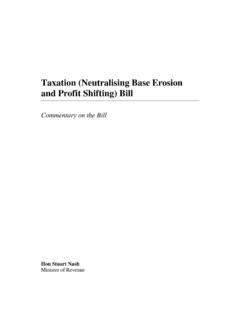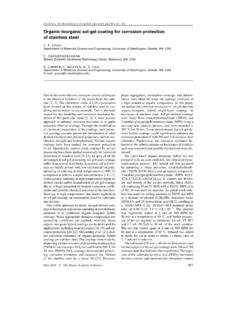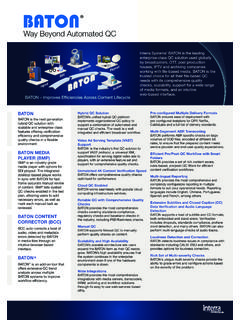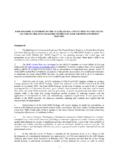Transcription of (Treaty Issues) - oecd.org
1 Public Discussion Draft BEPS ACTION 2: NEUTRALISE THE EFFECTS OF hybrid mismatch ARRANGEMENTS (Treaty Issues) 19 March 2014 2 May 2014 2 Comments on this note should be sent electronically (in Word format) by email to before on 2 May 2014 at the latest. It is the policy of the OECD to publish all responses (including the names of the responders) on the OECD website. This document does not necessarily reflect consensus views of either the Committee of Fiscal Affairs or of WP1 regarding the issues it addresses. Rather it reflects preliminary consideration of the issues since the publication of the Action Plan and seeks to identify issues for public comment.
2 It is considered that stakeholder comments are essential to advancing this work. 3 TABLE OF CONTENTS Introduction .. 4 1. Ensuring that dual resident entities are not used to obtain the benefits of treaties unduly .. 5 2. Ensuring that transparent entities are not used to obtain the benefits of treaties unduly .. 6 3. Interaction between the recommendations included in the WP11 Discussion Draft and the provisions of tax treaties .. 10 4 TREATY ISSUES RELATED TO THE WORK ON ACTION 2 (NEUTRALISE THE EFFECTS OF hybrid mismatch ARRANGEMENTS) Introduction 1. Action 2 of the BEPS Action Plan (Neutralise the effects of hybrid mismatch arrangements) reads as follows: The BEPS report calls for the development of instruments to put an end to or neutralise the effects of hybrid mismatch arrangements and arbitrage.
3 hybrid mismatch arrangements can be used to achieve unintended double non-taxation or long-term tax deferral by, for instance, creating two deductions for one borrowing, generating deductions without corresponding income inclusions, or misusing foreign tax credit and participation exemption regimes. Country rules that allow taxpayers to choose the tax treatment of certain domestic and foreign entities could facilitate hybrid mismatches. While it may be difficult to determine which country has in fact lost tax revenue, because the laws of each country involved have been followed, there is a reduction of the overall tax paid by all parties involved as a whole, which harms competition, economic efficiency, transparency and fairness.
4 ACTION 2 Neutralise the effects of hybrid mismatch arrangements Develop model treaty provisions and recommendations regarding the design of domestic rules to neutralise the effect ( double non-taxation, double deduction, long-term deferral) of hybrid instruments and entities. This may include: (i) changes to the OECD Model Tax Convention to ensure that hybrid instruments and entities (as well as dual resident entities) are not used to obtain the benefits of treaties unduly; (ii) domestic law provisions that prevent exemption or non-recognition for payments that are deductible by the payor; (iii) domestic law provisions that deny a deduction for a payment that is not includible in income by the recipient (and is not subject to taxation under controlled foreign company (CFC) or similar rules).
5 (iv) domestic law provisions that deny a deduction for a payment that is also deductible in another jurisdiction; and (v) where necessary, guidance on co-ordination or tie-breaker rules if more than one country seeks to apply such rules to a transaction or structure. Special attention should be given to the interaction between possible changes to domestic law and the provisions of the OECD Model Tax Convention. This work will be co-ordinated with the work on interest expense deduction limitations, the work on CFC rules, and the work on treaty shopping.
6 2. Since BEPS concerns related to hybrid instruments and entities arise from mismatches in domestic laws, the main outcomes of the work on Action 2 are expected to result from the work of Working Party 11 (WP11) on recommendations regarding the design of domestic rules to neutralise the effect of hybrid instruments and entities. These are the subject of a discussion draft that is released separately (the WP11 Discussion Draft ). 5 3. This note complements the WP11 Discussion Draft and deals with the parts of Action 2 that indicate that the outputs of the work on that action item may include changes to the OECD Model Tax Convention to ensure that hybrid instruments and entities (as well as dual resident entities) are not used to obtain the benefits of treaties unduly and that stress that [s]pecial attention should be given to the interaction between possible changes to domestic law and the provisions of the OECD Model Tax Convention.
7 4. This note first examines treaty issues related to dual-resident entities (section 1). It then includes a proposal for a new treaty provision dealing with transparent entities (section 2). Section 3 addresses the issue of the interaction between the recommendations included in the WP11 Discussion Draft and provisions of tax treaties. 5. At the outset, it should be noted that a number of proposals resulting from the work on Action 6 (Preventing Treaty Abuse), which are included in another discussion draft (the Treaty Abuse Discussion Draft ), will play an important role in ensuring that hybrid instruments and entities (as well as dual resident entities) are not used to obtain the benefits of treaties unduly.
8 The following proposals included in that other discussion draft are of particular relevance: Limitation on benefits rules. Rule aimed at arrangements one of the main purposes of which is to obtain treaty benefits. Rule aimed at dividend transfer transactions ( to subject the lower rate of tax provided by Art. 10(2)a) or by a treaty provision applicable to pension funds to a minimum shareholding period). Rule concerning a Contracting State s right to tax its own residents. Anti-abuse rule for permanent establishments situated in third States. 1. Ensuring that dual resident entities are not used to obtain the benefits of treaties unduly 6.
9 Action 2 refers expressly to possible changes to the OECD Model Tax Convention to ensure that dual resident entities are not used to obtain the benefits of treaties unduly. 7. The change to Art. 4(3) of the OECD Model Tax Convention that is included in the Treaty Abuse Discussion Draft will address some of the BEPS concerns related to the issue of dual-resident entities by providing that cases of dual treaty residence would be solved on a case-by-case basis rather than on the basis of the current rule based on place of effective management of entities, which creates a potential for tax avoidance in some countries.
10 The proposed revised version of Art. 4(3) that is put forward in that other discussion draft reads as follows: 3. Where by reason of the provisions of paragraph 1 a person other than an individual is a resident of both Contracting States, the competent authorities of the Contracting States shall endeavour to determine by mutual agreement the Contracting State of which such person shall be deemed to be a resident for the purposes of the Convention, having regard to its place of effective management, the place where it is incorporated or otherwise constituted and any other relevant factors.















